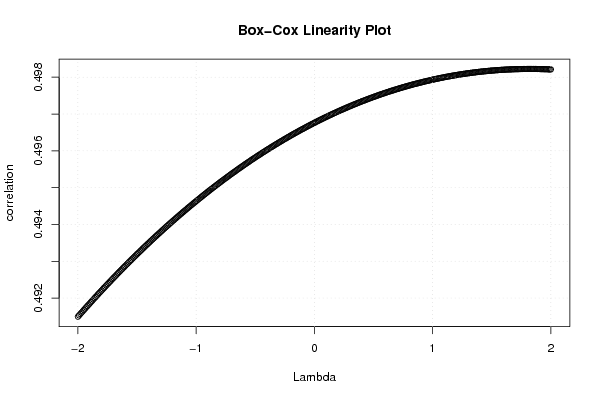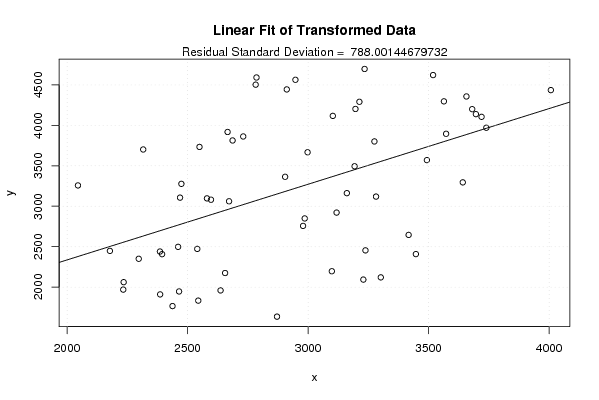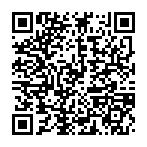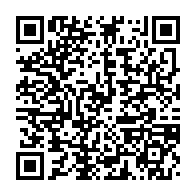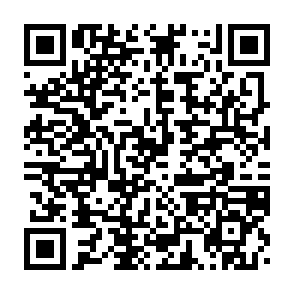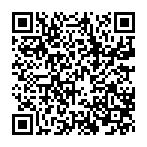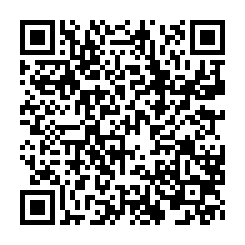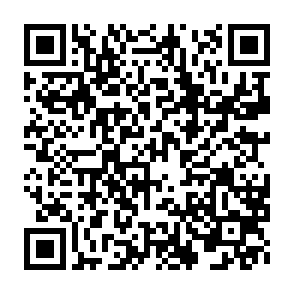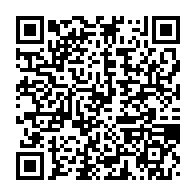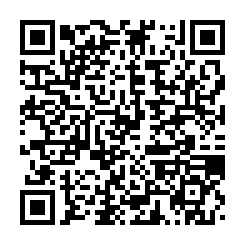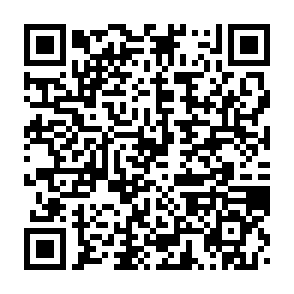Free Statistics
of Irreproducible Research!
Description of Statistical Computation | |||||||||||||||||||||||||||||||||||||||||||||
|---|---|---|---|---|---|---|---|---|---|---|---|---|---|---|---|---|---|---|---|---|---|---|---|---|---|---|---|---|---|---|---|---|---|---|---|---|---|---|---|---|---|---|---|---|---|
| Author's title | |||||||||||||||||||||||||||||||||||||||||||||
| Author | *The author of this computation has been verified* | ||||||||||||||||||||||||||||||||||||||||||||
| R Software Module | rwasp_boxcoxlin.wasp | ||||||||||||||||||||||||||||||||||||||||||||
| Title produced by software | Box-Cox Linearity Plot | ||||||||||||||||||||||||||||||||||||||||||||
| Date of computation | Fri, 07 Nov 2008 04:06:19 -0700 | ||||||||||||||||||||||||||||||||||||||||||||
| Cite this page as follows | Statistical Computations at FreeStatistics.org, Office for Research Development and Education, URL https://freestatistics.org/blog/index.php?v=date/2008/Nov/07/t1226056076oe90aj3atszz7bl.htm/, Retrieved Sun, 19 May 2024 06:43:40 +0000 | ||||||||||||||||||||||||||||||||||||||||||||
| Statistical Computations at FreeStatistics.org, Office for Research Development and Education, URL https://freestatistics.org/blog/index.php?pk=22470, Retrieved Sun, 19 May 2024 06:43:40 +0000 | |||||||||||||||||||||||||||||||||||||||||||||
| QR Codes: | |||||||||||||||||||||||||||||||||||||||||||||
|
| |||||||||||||||||||||||||||||||||||||||||||||
| Original text written by user: | |||||||||||||||||||||||||||||||||||||||||||||
| IsPrivate? | No (this computation is public) | ||||||||||||||||||||||||||||||||||||||||||||
| User-defined keywords | |||||||||||||||||||||||||||||||||||||||||||||
| Estimated Impact | 252 | ||||||||||||||||||||||||||||||||||||||||||||
Tree of Dependent Computations | |||||||||||||||||||||||||||||||||||||||||||||
| Family? (F = Feedback message, R = changed R code, M = changed R Module, P = changed Parameters, D = changed Data) | |||||||||||||||||||||||||||||||||||||||||||||
| F [Bivariate Kernel Density Estimation] [Various EDA topic...] [2008-11-07 10:38:01] [e5d91604aae608e98a8ea24759233f66] F RMPD [Trivariate Scatterplots] [Various EDA topic...] [2008-11-07 10:42:57] [e5d91604aae608e98a8ea24759233f66] F RMPD [Box-Cox Linearity Plot] [Various EDA topic...] [2008-11-07 11:06:19] [55ca0ca4a201c9689dcf5fae352c92eb] [Current] F RM D [Box-Cox Normality Plot] [Various EDA topic...] [2008-11-10 11:55:49] [e5d91604aae608e98a8ea24759233f66] F RMPD [Maximum-likelihood Fitting - Normal Distribution] [Various EDA topic...] [2008-11-10 12:02:10] [e5d91604aae608e98a8ea24759233f66] - RMPD [Testing Variance - Critical Value (Region)] [Various types of ...] [2008-11-10 12:36:06] [e5d91604aae608e98a8ea24759233f66] - P [Testing Variance - Critical Value (Region)] [Various types of ...] [2008-11-10 12:44:47] [e5d91604aae608e98a8ea24759233f66] - RMPD [Notched Boxplots] [Various types of ...] [2008-11-10 13:05:18] [e5d91604aae608e98a8ea24759233f66] - RMPD [Testing Variance - p-value (probability)] [Various types of ...] [2008-11-10 12:39:28] [e5d91604aae608e98a8ea24759233f66] | |||||||||||||||||||||||||||||||||||||||||||||
| Feedback Forum | |||||||||||||||||||||||||||||||||||||||||||||
Post a new message | |||||||||||||||||||||||||||||||||||||||||||||
Dataset | |||||||||||||||||||||||||||||||||||||||||||||
| Dataseries X: | |||||||||||||||||||||||||||||||||||||||||||||
99,29 98,69 107,92 101,03 97,55 103,02 94,08 94,12 115,08 116,48 103,42 112,51 95,55 97,53 119,26 100,94 97,73 115,25 92,8 99,2 118,69 110,12 110,26 112,9 102,17 99,38 116,1 103,77 101,81 113,74 89,67 99,5 122,89 108,61 114,37 110,5 104,08 103,64 121,61 101,14 115,97 120,12 95,97 105,01 124,68 123,89 123,61 114,76 108,75 106,09 123,17 106,16 115,18 120,6 109,48 114,44 121,44 129,48 124,32 112,59 | |||||||||||||||||||||||||||||||||||||||||||||
| Dataseries Y: | |||||||||||||||||||||||||||||||||||||||||||||
1946,81 1765,9 1635,25 1833,42 1910,43 1959,67 1969,6 2061,41 2093,48 2120,88 2174,56 2196,72 2350,44 2440,25 2408,64 2472,81 2407,6 2454,62 2448,05 2497,84 2645,64 2756,76 2849,27 2921,44 3080,58 3106,22 3119,31 3061,26 3097,31 3161,69 3257,16 3277,01 3295,32 3363,99 3494,17 3667,03 3813,06 3917,96 3895,51 3733,22 3801,06 3570,12 3701,61 3862,27 3970,1 4138,52 4199,75 4290,89 4443,91 4502,64 4356,98 4591,27 4696,96 4621,4 4562,84 4202,52 4296,49 4435,23 4105,18 4116,68 | |||||||||||||||||||||||||||||||||||||||||||||
Tables (Output of Computation) | |||||||||||||||||||||||||||||||||||||||||||||
| |||||||||||||||||||||||||||||||||||||||||||||
Figures (Output of Computation) | |||||||||||||||||||||||||||||||||||||||||||||
Input Parameters & R Code | |||||||||||||||||||||||||||||||||||||||||||||
| Parameters (Session): | |||||||||||||||||||||||||||||||||||||||||||||
| Parameters (R input): | |||||||||||||||||||||||||||||||||||||||||||||
| R code (references can be found in the software module): | |||||||||||||||||||||||||||||||||||||||||||||
n <- length(x) | |||||||||||||||||||||||||||||||||||||||||||||
